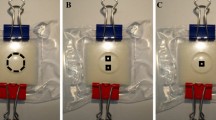Abstract
This study examined habitat use patterns by adult whiteflies, Bemisia argentifolii Bellows and Perring, in response to predators, Delphastus catalinae (Horn), at different spatial scales. When female whiteflies were confined to small arenas with leaf discs from which they could not escape, whiteflies significantly delayed settling on leaf discs when predators were present compared to when no predators were introduced. The presence of D. catalinae altered the vertical distribution of adult whiteflies (sex ratio = 1:1) on cucumber plants; adult whiteflies moved upward faster over time within the plant canopy when predators were present mainly on the lower leaves of the plants compared to whiteflies on plants without predators. Most D. catalinae remained in the lower parts of the plants during the experiment. Therefore, we inferred that female whiteflies more quickly moved to the upper plant strata to reduce the risk of predation of their progeny; this would induce subsequent movement of males seeking mates. Introduction of D. catalinae onto a cucumber plant with high whitefly density did not cause increased dispersal of adult whiteflies (sex ratio = 1:1) into neighboring uninfested plants. The results indicate that predator-avoidance behaviors by adult B. argentifolii differed at different spatial scales. The predator-avoidance behavior may have a negative impact at the within-plant scale by inducing more whiteflies to move into upper plant strata. However, the effect of predators on the among-plant dispersal of whiteflies was not significant.






Similar content being viewed by others
References
Ballabeni P, Wlodarczyk M, Rahier M (2001) Does enemy-free space for eggs contribute to a leaf beetle’s oviposition preference for a nutritionally inferior host plant? Funct Ecol 15:318–324
Costamagna AC, Landis DA (2011) Lack of strong refuges allows top-down control of soybean aphid by generalist natural enemies. Biol Control 57:184–192
Dixon AFG (2000) Insect predator–prey dynamics: ladybird beetles and biological control. Cambridge University Press, Cambridge
Fenigstein A, Eliyahu M, Gan-Mor S, Veierov D (2001) Effects of five vegetable oils on the sweet potato whitefly Bemisia tabaci. Phytoparasitica 29:197–206
Gerling D, Alomar O, Arnó J (2001) Biological control of Bemisia tabaci using predators and parasitoids. Crop Prot 20:779–799
Guershon M, Gerling D (1999) Predatory behavior of Delphastus pusillus in relation to the phenotypic plasticity of Bemisia tabaci nymphs. Entomol Exp Appl 92:239–248
Guershon M, Gerling D (2006) Effects of plant and prey characteristics on the predatory behavior of Delphastus catalinae. Entmol Exp Appl 121:15–21
Hoelmer KA, Osborne LS, Yokomi RK (1993) Reproduction and feeding behavior of Delphastus pusillus (Coleoptera: Coccinellidae), a predator of Bemisia tabaci (Homoptera: Aleyrodidae). J Econ Entomol 86:322–329
Hou M, Lu W, Wen J (2007) Within-plant distribution of Bemisia tabaci (Homoptera: Aleyrodidae) adults and immatures on greenhouse-grown winter cucumber plants. J Econ Entomol 100:1160–1165
Lee DH, Nyrop JP, Sanderson JP (2010) Effect of host experience of the greenhouse whitefly, Trialeurodes vaporariorum, on trap crop** effectiveness. Entomol Exp Appl 137:193–203
Lee DH, Nyrop JP, Sanderson JP (2011) Avoidance of natural enemies by adult whiteflies, Bemisia argentifolii, and effects on host plant choice. Biol Control 58:302–309
Lima SL (1998) Nonlethal effects in the ecology of predator–prey interactions. Bioscience 48:25–34
Luttbeg B, Kerby JL (2005) Are scared prey as good as dead? Trends Ecol Evol 20:416–418
Naranjo SE (2001) Conservation and evaluation of natural enemies in IPM systems for Bemisia tabaci. Crop Prot 20:835–852
Nelson EH (2007) Predator avoidance behavior in the pea aphid: costs, frequency, and population consequences. Oecologia 151:22–32
Nomikou M, Janssen A, Sabelis MW (2003) Herbivore host plant selection: whitefly learns to avoid host plants that harbour predators of her offspring. Oecologia 136:484–488
Obrycki JJ, Kring TJ (1998) Predaceous Coccinellidae in biological control. Ann Rev Entomol 43:295–321
Perry JN (1998) Measures of spatial pattern of counts. Ecology 79:1008–1017
Preisser EL, Bolnick DI (2008) The many faces of fear: comparing the pathways and impacts of nonconsumptive predator effects on prey populations. PLoS One 3:e2465. doi:10.1371/journal.pone.0002465
Preisser EL, Bolnick DI, Benard MF (2005) Scared to death? The effects of intimidation and consumption in predator–prey interactions. Ecology 86:501–509
Preisser EL, Bolnick DI, Grabowski JH (2009) Resource dynamics influence the strength of nonconsumptive predator effects on prey. Ecol Lett 12:315–323
Relyea RA (2001) The relationship between predation risk and antipredator responses in larval anurans. Ecology 82:541–554
Škaloudová B, Zemek R, Křivan V (2007) The effect of predation risk on an acarine system. Anim Behav 74:813–821
Thaler JS, Griffin CAM (2008) Relative importance of consumptive and non-consumptive effects of predators on prey and plant damage: the influence of herbivore ontogeny. Entomol Exp Appl 128:34–40
Thaler JS, McArt SH, Kaplan I (2012) Compensatory mechanisms for ameliorating the fundamental tradeoff between predator avoidance and foraging. Proc Natl Acad Sci USA 109:12075–12080
Walzer A, Schausberger P (2009) Non-consumptive effects of predatory mites on thrips and its host plant. Oikos 118:934–940
Werner EE, Peacor SD (2003) A review of trait-mediated indirect interactions in ecological communities. Ecology 84:1083–1100
Yang T-C, Chi H (2006) Life tables and development of Bemisia argentifolii (Homoptera: Aleyrodidae) at different temperatures. J Econ Entomol 99:691–698
Acknowledgments
We thank KC Bennett for her technical support when growing insects and plants. This study was funded in part by the Griswold Endowment (Department of Entomology, Cornell University) and the Post/Schenkel Memorial Council (Department of Horticulture, Cornell University).
Author information
Authors and Affiliations
Corresponding author
Rights and permissions
About this article
Cite this article
Lee, DH., Nyrop, J.P. & Sanderson, J.P. Non-consumptive effects of the predatory beetle Delphastus catalinae (Coleoptera: Coccinellidae) on habitat use patterns of adult whitefly Bemisia argentifolii (Hemiptera: Aleyrodidae). Appl Entomol Zool 49, 599–606 (2014). https://doi.org/10.1007/s13355-014-0294-7
Received:
Accepted:
Published:
Issue Date:
DOI: https://doi.org/10.1007/s13355-014-0294-7




